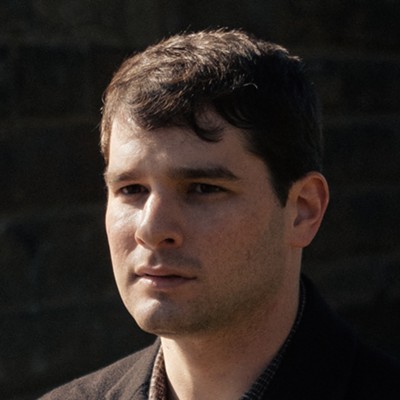Miami is a city without a proper autumn, where the only pleasant chill of the year arrives for about a week in January, where fallen leaves are the result of hurricane-force winds, and where people don't look any weirder on Halloween than they do every other day.
Yet thanks to the Institute of Contemporary Art Miami (ICA Miami), the Magic City is getting a very special pumpkin patch this fall. These aren't the kind of pumpkins you can take home and turn into jack-o'-lanterns, however. They're vibrant sculptures placed in a mirrored room, made to look as if the patch stretches on forever.
For the first time, Miami will host an "infinity mirror" room, a one-of-a-kind art installation by the megapopular Japanese artist Yayoi Kusama. All the Eternal Love I Have for the Pumpkins will be on display near the ICA's home base in the Design District Saturday, October 12, through the end of January.
According to ICA's artistic director, Alex Gartenfeld, the museum jumped at the chance to host part of the exhibition when it found out it was being held by a Miami-based gallery, Inigo Philbrick Gallery, which also has an office in London. The piece will be on loan from the gallery for the duration of the show.
What makes Kusama's installation so special isn't just the nature of it. It's true that the artist's works are very photogenic: Her other mirrored rooms have been known to include colored lights floating in space, and the glowing yellow gourds with black polka dots will look great on social media. But this isn't just another Museum of Ice Cream-style Instagram trap. Kusama wants viewers in her mirrored rooms to think about the nature of infinity. She wants spectators to understand why she makes art and how she overcomes challenges to create such stunning visuals.
Yayoi Kusama was born in 1929 in the small city of Matsumoto in Japan's rural Nagano prefecture, best known for its black-walled samurai castle nicknamed "Karasu-jo" ("Crow Castle"). She had a difficult childhood, to say the least. Her family was wealthy and conservative, expecting their daughter to marry and raise children and discouraging her from artistic practice. Her father was a womanizer; her mother, jealous of his affairs, used Kusama as a personal spy, exposing her to sexual situations and giving her a traumatic, ambivalent relationship with sex from an early age.
It was around this time, at age 10, that she began to have hallucinations. In one memory, she was looking at a red flower pattern on a tablecloth when that pattern multiplied and spread across the entire room and across her body. "I felt as if I had begun to self-obliterate, to revolve in the infinity of endless time and the absoluteness of space and be reduced to nothingness," she wrote in her 1975 manifesto, "The Struggle and Wanderings of My Soul."
In her mirrored rooms, Kusama wants viewers to think about the nature of infinity.
tweet this
These became regular incidents. The young Kusama found that art was the only way to deal with her visions. She would draw the same things she saw: mostly polka dots — now her primary calling card — but also flowers, nets, and other repetitive patterns. Concentrating on the drawings distracted her mind and allowed her to depict what she saw, but her family failed to understand. Her mother tore up her drawings before she could finish them.
Kusama needed to escape the black castle of her upbringing. Alongside her domineering mother, she lived through the depression of the '30s, during which her family struggled and sold many of their assets; the tightening grip of the Imperial Japanese government just before World War II; the war itself, during which she sewed parachutes in a factory; and the bleak postwar period where destruction and deprivation reigned. After exhibiting briefly in her home country, she began writing letters to Georgia O'Keeffe to seek advice, and in the late '50s, at the age of 27, she sewed dollar bills into the sleeves of her kimonos and left her homeland, eventually settling in New York.
It was there that she became a scandalous yet underappreciated force in the American art world. Between relationships with Joseph Cornell (they reportedly never consummated but did draw each other nude) and Donald Judd, she produced an astounding variety of work that art historians now consider a bridge between the abstract expressionism of the '50s and the pop art of the '60s. Along with her first mirrored rooms, Kusama created "infinity net" paintings based on her hallucinations as well as sculptures called "accumulations" — objects such as chairs and rowboats covered in phallic protrusions made of fabric, created as a way of dealing with her sexual hangups. "I am terrified by just the thought of something long and ugly like a phallus entering me, and that is why I make so many of them," she said at the time.

In the mid- to late '60s, Kusama began to produce public spectacles, "happenings," and other stunts to demand attention, declaring, "Publicity is part of my art." Many of them were sexual in nature and scandalized her family. At the 1966 Venice Biennale, in what some observers saw as a critique of the commercial art market, she attempted to auction off pieces of her Narcissus Garden, made of silver balls floating in a pond, one ball at a time for around $2 each. The authorities stopped the uninvited installation immediately. She once wrote an open letter to President Nixon offering to have sex with him in exchange for stopping the Vietnam War. In 1969, one of her performance art pieces, the unannounced, unsanctioned Grand Orgy to Awaken the Dead at the MoMA, featured a group of young nude men and women imitating the sculptures in the museum's garden. The New York Daily News put it on the front page, writing, "Crowd takes it in stride. (Some took strides to get closer)."
Despite the provocative public displays, commercial success eluded Kusama, primarily due to sexism in the art world. Women artists were in such low demand during that period that even female gallerists would balk at showing their work. Kusama often found herself living hand-to-mouth and relying on benefactors. Male artists such as Andy Warhol and Claes Oldenburg would frequently "borrow" from her works and find greater success, causing her more distress. Months after she displayed her first mirrored room, another, more successful mirrored artwork, by Lucas Samaras, debuted at the blue-chip Pace Gallery. In response, Kusama threw herself out a window.
Despite the provocative public displays, commercial success eluded Kusama, primarily due to sexism in the art world.
tweet this
She returned to Japan in 1973. Having been chewed up and spit out by New York, she attempted a brief career as an art dealer. Four years after her return, however, she found a very unlikely sanctuary.
In 1977, Yayoi Kusama checked herself into the Seiwa Hospital for the Mentally Ill in Tokyo, to this day her residence of choice. It was in this stable environment, nurtured by doctors interested in art therapy, that she began to rehabilitate her career and her mental health. From a workspace at the hospital and from her studio nearby in Shinjuku, aided by assistants, she began to churn out work, from paintings and sculptures to novels, poems, and other literature. Museums and galleries in Japan began to exhibit her work more regularly, and in 1993, she returned to the Venice Biennale as the first solo artist to design the Japanese pavilion. She presented an infinity room filled with spotted pumpkins, much like the one being shown in Miami.
Since then, Kusama, now rarely seen without her hair in a bright-red Agnès Varda-style bob, has become a commercial behemoth. Her trademark polka dots have covered everything from cell phones to cosmetics. Famously, she collaborated with Marc Jacobs on a fashion collection for Louis Vuitton. Her mirrored rooms have been permanently installed in locations as far-flung as Jakarta, Indonesia; and Phoenix, Arizona. And versions of her Narcissus Garden, removed upon its debut in Venice, have been shown at the Whitney Biennial in New York, Jardin des Tuileries in Paris, and Instituto Inhotim in Brazil. Today, at the age of 90, Yayoi Kusama is the highest-selling female artist on Earth.
In 2006, in an interview with New York magazine, Kusama gave her opinion of Warhol. "I had already exceeded him during my stay in New York in the Sixties," she declared. "He lived near me and appropriated my ideas, only he was too late because I had already realized them. We don't hear his name now so much in Japan."
When All the Eternal Love I Have for the Pumpkins debuted, it was part of the traveling exhibition "Yayoi Kusama: Infinity Mirrors." The show opened at Washington, D.C.'s Hirshhorn Museum and gave the institution its highest attendance numbers in decades. The exhibit proceeded to sell out at every stop: Seattle, Los Angeles, Toronto, Cleveland, and Atlanta.
That being said, ICA Miami expects the demand to see this one small part of that larger exhibition to be no less sensational. And because the work can be experienced by only one person at a time, the museum is instituting an unconventional viewing policy.
"We're anticipating extremely high demand, and we want to make sure everyone has a positive experience with the artwork," Gartenfeld says.
Try to understand you're seeing through the eyes of another, into her strange existence.
tweet this
The installation will be open Thursday through Sunday each week. Thursdays, the work will be free to view like the rest of ICA's programming. But due to demand, it can be viewed only on a first-come, first-served basis — meaning long lines might be a possibility. Fridays, Saturdays, and Sundays, visitors will be able to buy a timed entry ticket for $15.
Simultaneously, ICA will offer educational programming alongside the installation run. The museum will conduct a series of free student visits during the piece's four-month run, when "a specially designed curriculum focused on Kusama's life and work" will be taught, according to a statement from the museum. There will also be a Kusama merchandise shop supplied by the artist's studio.
According to ICA, each visitor will be allowed to spend only one minute in Kusama's little world. So here's a recommendation: Don't take the phone out right away. Don't think about how many likes your Instagram post will get. Instead, look around. Look at your reflection in the sprawling field of pumpkins. See how vast it seems. Try to understand you're seeing through the eyes of another, into her strange existence. Try, and you might just reach infinity.
Yayoi Kusama's All the Eternal Love I Have for the Pumpkins. Thursdays through Sundays from Saturday, October 12, 2019, through Friday, January 31, 2020, at 112 NE 41st St., Suite 106, Miami; 305-901-5272; icamiami.org. Admission is free Thursdays. Tickets cost $15 Fridays, Saturdays, and Sundays.











